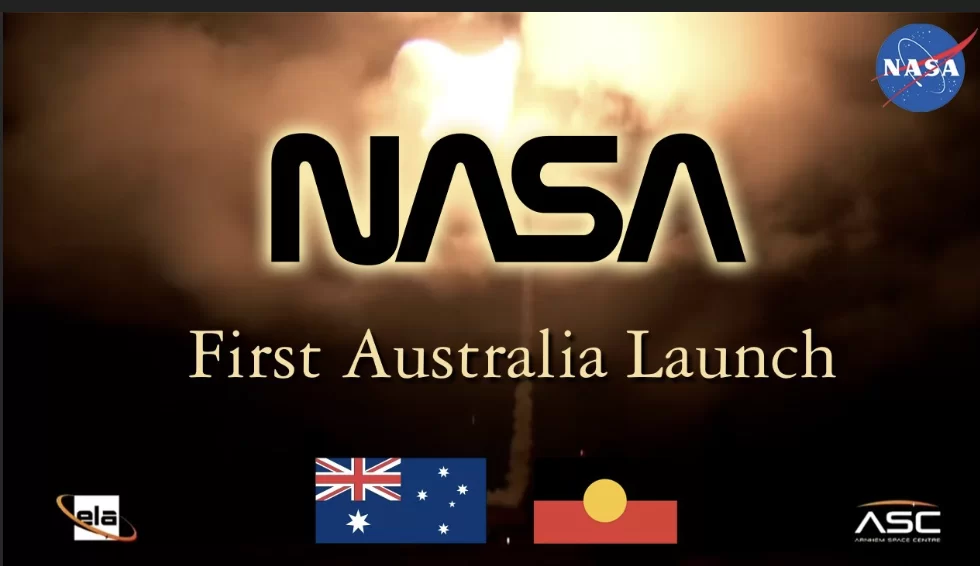Client: NASA via Equatorial Launch Australia
Event Management: SOCIETY
Venue: Arnhem Space Centre; near Nhulunbuy, Northern Territory
On the night of 26th June, 2022, a suborbital sounding rocket blasted off from ELA’s Arnhem Space Centre complex. The historic launch was NASA’s first one from a fully commercial spaceport, which also happens to be the only commercially-owned and run multi-user equatorial launch site in the world.

Challenge
The Dome Company was hired to provide a 15 metre diameter dome to be used as a VIP viewing point for the first commercial Australian rocket launch at the Arnhem Space Centre. The site is some 30 kilometres from Nhulunbuy, which is in turn over 1000 kilometres by road from Darwin.
The dome was required to have a large clear window for viewing, and to have ample ventilation. Everything for the dome build had to be road freighted to site from our base in NSW.
Solution
All the components for the 15 metre dome were transported in two crates, taking up only 1.2 x 1.2m floor space each. The stillages included a de-constructed set of our proprietary lifting equipment, 30 marquee pegs and even a jack hammer for driving in the pegs.
The dome had a huge bay ‘window’ in clear vinyl, and also 5 doors with roll up fabric and 4 sections of large roll up vents around the bottom of the canopy for cross ventilation.
Setup and execution
The two dome stillages were delivered efficiently to the site via road train from Darwin.
Local construction workers were provided by an Aboriginal organisation, Gumatj Corporation. With the supervision of Robbie Lusher from The Dome Company the 15 metre dome was completely built in about 6 hours.
Large LED screens were hung off the strong dome framework and several kilometres of CAT cable were laid through the bush to connect to a live video feed from the rocket launch site (about 3 – 5 kilometres away)
VIP guests were flown to Darwin, then a private chartered flight to Nhulunbuy, and the final 30 kms of red dirt road to the dome site.
After several delays (due to low cloud and some rain) the rocket was successfully launched around midnight.
The dome was dismantled in about 3 hours the next day.
Outcome and benefits
The ‘sounding’ rocket carried and X-ray Quantum Calorimeter (XQC) on an atmospheric observation and sensing platform, and experiment developed by The University of Wisconsin. Its job is to detect and measure interstellar X-rays from Alpha Centauri A and B. With this payload, NASA aims to better understand how the material between the stars influences the structure and evolution of galaxies and stars.
The rocket carried the science instrument to an altitude of 326km before descending by parachute and landing southwest of the launch site. The instrument and the motors were then recovered.
The rocket was the first of three Black Brant IX rockets being launched from the ASC complex over the next few months, with the latter two planned for early July. Each rocket carries a unique payload tasked with observing a part of the sky that can only be seen from the Southern Hemisphere, which is a major reason why NASW chose ELA as its launch operator.
Testimonials
Michael Jones, Executive Chairman and Group CEO of ELA, was delighted to announce the successful completion of the company’s first commercial space launch with NASA.
“We could never have dreamed of having such a supportive, experienced and professional partner as NASA. They have been unbelievably generous in helping us through this journey and we will be a much better organisation for their support,” he acknowledged.
“Today, we have achieved a remarkable feat and made a huge mark in the history of Australia’s journey in space,” Mr Jones added.
Conclusion
Many people gathered on launch day for the momentous occasion. Witnessing the launch at the Arnhem Space Centre were the Chief Minister Natasha Fyles, Consul General of the United States Kathleen Lively, senior members of the Australian Space Agency and the space industry, Traditional Owners, the Northern Territory Government, stakeholders and supporters of ELA.

